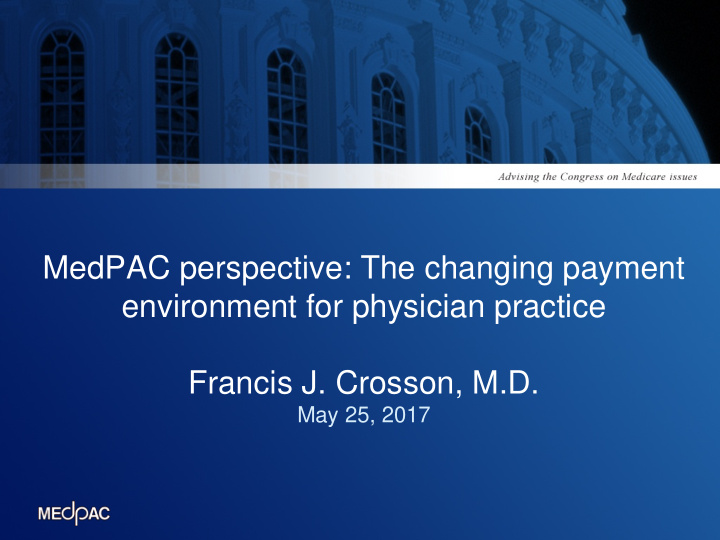



MedPAC perspective: The changing payment environment for physician practice Francis J. Crosson, M.D. May 25, 2017
MedPAC Payment Principles Assure beneficiary access to high quality care Pay providers fairly Provide for taxpayers and beneficiaries to receive value for their dollars 2
MedPAC Policy Interests Rebalance the PFS toward primary care Improve payment fairness among physician specialties Ensure a physician/other professional workforce to support beneficiary choice of provider and delivery reform success Improve information used in determining fee schedule values The large number of codes makes it difficult to maintain the accuracy of the fee schedule in a timely manner There is evidence that the time component of many procedural codes are out of date Further improve physician payment, including MACRA elements: A-APMs and MIPS 3
MedPAC Formal Recommendations CMS should broaden the sources of and more regularly update input on PFS relative valuations, including the time component of physician work (2006, 2011) Congress should improve payments for primary care, on a budget-neutral basis- Differential updates (2011-letter to CMS) Annual targets for adjusting mispriced services (ibid) Per-beneficiary payment for primary care (2015) 4
MedPAC Formal Recommendations Congress should reduce or eliminate differences in payment rates between HOPDs and physician offices for selected ambulatory payment classifications (2012,2014,2017) Congress should change the way physicians are paid for Part B drugs, including by creating incentives for appropriate drug selection and utilization (June, 2017) 5
Ongoing MedPAC Areas of Focus Can we identify patterns of “low-value” physician services and make recommendations accordingly? What recommendations should we make regarding the implementation of A-APMs and MIPS?- Make A-APMs more attractive; MIPS -> A-APM But…A-APM physician accountability for results Much simpler, more accurate, more relevant quality measurement in MIPS 6
Issues with Current MIPS Framework Uses hundreds of quality measures, many of which are topped out and narrowly targeted to specific specialties and cases Data elements for meaningful use and practice improvement activities are attestation-only Relatively small number of patients for an individual clinician contribute to noisy performance scores Individual measures chosen by the clinician used to assess clinicians’ performance, thus results not comparable across clinicians Overall, MIPS will likely fail to identify high- or low-value clinicians and will not be useful for Beneficiaries (in selecting high-value clinicians) Clinicians (in understanding their performance and what to do to improve) The Medicare program (in adjusting payments based on value) 7
Discussion Idea: MIPS All clinicians contribute to quality pool through a percentage withhold Clinicians could be eligible for a quality adjustment if they elect a clinician-defined “virtual group” “Virtual group” must be sufficiently large to detect performance on population measures Clinicians who don’t elect virtual group or join A-APM lose withhold 8
Discussion Idea: Rebalancing MIPS Towards A-APMs MIPS quality withhold automatically returned to clinicians in A-APMs, incentive for clinicians to join A-APMs Move MIPS “exceptional performance” fund to A-APMs to fund asymmetric risk corridors; $500 million each year (2019-2024) 9
Recommend
More recommend